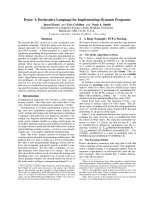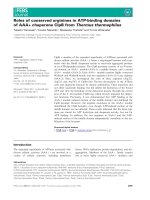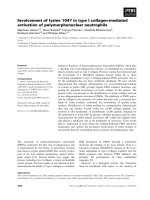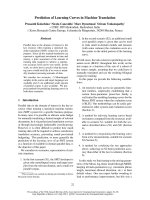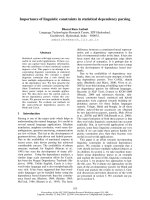Báo cáo khoa học: "FACTORIZATION OF LANGUAGE CONSTRAINTS IN SPEECH RECOGNITION" pptx
Bạn đang xem bản rút gọn của tài liệu. Xem và tải ngay bản đầy đủ của tài liệu tại đây (676.88 KB, 8 trang )
FACTORIZATION OF LANGUAGE CONSTRAINTS IN SPEECH RECOGNITION
Roberto Pieraccini and Chin-Hui Lee
Speech Research Department
AT&T Bell Laboratories
Murray Hill, NJ 07974, USA
ABSTRACT
Integration of language constraints into a
large vocabulary speech recognition system
often leads to prohibitive complexity. We
propose to factor the constraints into two
components. The first is characterized by a
covering grammar which is small and easily
integrated into existing speech recognizers. The
recognized string is then decoded by means of an
efficient language post-processor in which the
full set of constraints is imposed to correct
possible errors introduced by the speech
recognizer.
1. Introduction
In the past, speech recognition has mostly
been applied to small domain tasks in which
language constraints can be characterized by
regular grammars. All the knowledge sources
required to perform speech recognition and
understanding, including acoustic, phonetic,
lexical, syntactic and semantic levels of
knowledge, are often encoded in an integrated
manner using a finite state network (FSN)
representation. Speech recognition is then
performed by finding the most likely path
through the FSN so that the acoustic distance
between the input utterance and the recognized
string decoded from the most likely path is
minimized. Such a procedure is also known as
maximum likelihood decoding, and such systems
are referred to as integrated systems. Integrated
systems can generally achieve high accuracy
mainly due to the fact that the decisions are
delayed until enough information, derived from
the knowledge sources, is available to the
decoder. For example, in an integrated system
there is no explicit segmentation into phonetic
units or words during the decoding process. All
the segmentation hypotheses consistent with the
introduced constraints are carried on until the
final decision is made in order to maximize a
global function. An example of an integrated
system was HARPY (Lowerre, 1980) which
integrated multiple levels of knowledge into a
single FSN. This produced relatively high
performance for the time, but at the cost of
multiplying out constraints in a manner that
expanded the grammar beyond reasonable
bounds for even moderately complex domains,
and may not scale up to more complex tasks.
Other examples of integrated systems may be
found in Baker (1975) and Levinson (1980).
On the other hand modular systems clearly
separate the knowledge sources. Different from
integrated systems, a modular system usually
make an explicit use of the constraints at each
level of knowledge for making hard decisions.
For instance, in modular systems there is an
explicit segmentation into phones during an
early stage of the decoding, generally followed
by lexical access, and by syntactic/semantic
parsing. While a modular system, like for
instance HWIM (Woods, 1976) or HEARSAY-II
(Reddy, 1977) may be the only solution for
extremely large tasks when the size of the
vocabulary is on the order of 10,000 words or
more (Levinson, 1988), it generally achieves
lower performance than an integrated system in a
restricted domain task (Levinson, 1989). The
degradation in performance is mainly due to the
way errors propagate through the system. It is
widely agreed that it is dangerous to make a long
series of hard decisions. The system cannot
recover from an error at any point along the
chain. One would want to avoid this chain-
architecture and look for an architecture which
would enable modules to compensate for each
other. Integrated approaches have this
compensation capability, but at the cost of
multiplying the size of the grammar in such a
way that the computation becomes prohibitive
for the recognizer. A solution to the problem is
to factorize the constraints so that the size of the
299
grammar, used for maximum likelihood
decoding, is kept within reasonable bounds
without a loss in the performance. In this paper
we propose an approach in which speech
recognition is still performed in an integrated
fashion using a
covering grammar
with a smaller
FSN representation. The decoded string of
words is used as input to a second module in
which the complete set of task constraints is
imposed to correct possible errors introduced by
the speech recognition module.
2. Syntax Driven Continuous Speech
Recognition
The general trend in large vocabulary
continuous speech recognition research is that of
building integrated systems (Huang, 1990;
Murveit, 1990; Paul, 1990; Austin, 1990) in
which all the relevant knowledge sources,
namely acoustic, phonetic, lexical, syntactic, and
semantic, are integrated into a unique
representation.
The speech signal, for the
purpose of speech recognition, is represented by
a sequence of acoustic patterns each consisting
of a set of measurements taken on a small
portion of signal (generally on the order of 10
reset). The speech recognition process is carried
out by searching for the best path that interprets
the sequence of acoustic patterns, within a
network that represents, in its more detailed
structure, all the possible sequences of acoustic
configurations. The network, generally called a
decoding network,
is built in a hierarehical way.
In current speech recognition systems, the
syntactic structure of the sentence is
represented
generally by a regular grammar that is typically
implemented as a finite state network
(syntactic
FSN).
The ares of the syntactic FSN represent
vocabulary items, that are again represented by
FSN's
(lexical FSN),
whose arcs are phonetic
units. Finally every phonetic unit is again
represented by an FSN
(phonetic FSN). The
nodes of the phonetic FSN, often referred to as
acoustic states,
incorporate particular acoustic
models developed within a statistical framework
known as hidden Markov model (HMM). 1 The
1. The reader is referred to Rabiner (1989) for a tutorial
introduction of HMM.
model pertaining to an acoustic state allows
computation of a likelihood score, which
represents the goodness of acoustic match for the
observation of a given acoustic patterns. The
decoding network is obtained by representing the
overall syntactic FSN in terms of acoustic states.
Therefore the recognition problem can be
stated as follows. Given a sequence of acoustic
patterns, corresponding to an uttered sentence,
find the sequence of acoustic states in the
decoding network that gives the highest
likelihood score when aligned with the input
sequence of acoustic patterns. This problem can
be solved efficiently and effectively using a
dynamic programming search procedure. The
resulting optimal path through the network gives
the optimal sequence of acoustic states, which
represents a sequence of phonetic units, and
eventually the recognized string of words.
Details about the speech recognition system we
refer to in the paper can be found in Lee
(1990/1). The complexity of such an algorithm
consists of two factors. The first is the
complexity arising from the computation of the
likelihood scores for all the possible pairs of
acoustic state and acoustic pattern. Given an
utterance of fixed length the complexity is linear
with the number of
distinct
acoustic states. Since
a finite set of phonetic units is used to represent
all the words of a language, the number of
possible different acoustic states is limited by the
number of distinct phonetic units. Therefore the
complexity of the local likelihood computation
factor does not depend either on the size of the
vocabulary or on the complexity of the language.
The second factor is the combinatorics or
bookkeeping that is necessary for carrying out
the dynamic programming optimization.
Although the complexity of this factor strongly
depends on the implementation of the search
algorithm, it is generally true that the number of
operations grows linearly with the number of
arcs in the decoding network. As the overall
number of arcs in the decoding network is a
linear function of the number of ares in the
syntactic network, the complexity of the
bookkeeping factor grows linearly with the
number of ares in the FSN representation of the
grammar.
300
The syntactic FSN that represents a certain
task language may be very large if both the size
of the vocabulary and the munber of syntactic
constraints are large. Performing speech
recognition with a very large syntactic FSN
results in serious computational and memory
problems. For example, in the DARPA resource
management task (RMT) (Price, 1988) the
vocabulary consists of 991 words and there are
990 different basic sentence structures
(sentence
generation templates, as
explained later). The
original structure of the language (RMT
grammar), which is given as a non-deterministic
finite state semantic grammar (Hendrix, 1978),
contains 100,851 rules, 61,928 states and
247,269 arcs. A two step automatic optimization
procedure (Brown, 1990) was used to compile
(and minimize) the nondeterministic FSN into a
deterministic FSN, resulting in a machine with
3,355 null arcs, 29,757 non-null arcs, and 5832
states. Even with compilation, the grammar is
still too large for the speech recognizer to handle
very easily. It could take up to an hour of cpu
time for the recognizer to process a single 5
second sentence, running on a 300 Mflop Alliant
supercomputer (more that 700 times slower than
real time). However, if we use a simpler
covering
grammar, then recognition time is no
longer prohibitive (about 20 times real time).
Admittedly, performance does degrade
somewhat, but it is still satisfactory (Lee,
1990/2) (e.g. a 5% word error rate). A simpler
grammar, however, represents a superset of the
domain language, and results in the recognition
of word sequences that are outside the defined
language. An example of a covering grammars
for the RMT task is the so called
word-pair
(WP) grammar where, for each vocabulary word
a list is given of all the words that may follow
that word in a sentence. Another covering
grammar is the so called null grammar (NG), in
which a word can follow any other word. The
average word branching factor is about 60 in the
WP grammar. The constraints imposed by the
WP grammar may be easily imposed in the
decoding phase in a rather inexpensive
procedural way, keeping the size of the FSN
very small (10 nodes and 1016 arcs in our
implementation (Lee, 1990/1) and allowing the
recognizer to operate in a reasonable time (an
average of 1 minute of CPU time per sentence)
(Pieraccini, 1990). The sequence of words
obtained with the speech recognition procedure
using the WP or NG grammar is then used as
input to a second stage that we call the
semantic
decoder.
3. Semantic Decoding
The RMT grammar is represented, according
to a context free formalism, by a set of 990
sentence generation templates
of the form:
Sj
= ~ ai2 a~, (1)
where a generic ~ may be either a terminal
symbol, hence a word belonging to the 991 word
vocabulary and identified by its orthographic
transcription, or a non-terminal symbol
(represented by sharp parentheses in the rest of
the paper). Two examples of sentence
generation templates and the corresponding
production of non-terminal symbols are given in
Table 1 in which the symbol e corresponds to the
empty string.
A characteristic of the the RMT grammar is
that there are no reeursive productions of the
kind:
(,4) = al a2 -'. (A)
a/v
(2)
For the purpose of semantic decoding, each
sentence template may then be represented as a
FSN where the arcs correspond either to
vocabulary words or to categories of vocabulary
words. A category is assigned to a vocabulary
word whenever that vocabulary word is a unique
element in the tight hand side of a production.
The category is then identified with the symbol
used to represent the non-terminal on the left
hand side of the production. For instance,
following the example of Table 1, the words
SHIPS, FRIGATES, CRUISERS, CARRIERS,
SUBMARINES, SUBS, and VESSELS belong to
the category <SH/PS>, while the word LIST
belongs to the category <LIST>. A special word,
the null word, is included in the vocabulary and
it is represented by the symbol e.
Some of the non-terminal symbols in a given
sentence generation template are essential for the
representation of the meaning of the sentence,
while others just represent equivalent syntactic
variations with the same meaning. For instance,
301
GIVE A LIST OF <OPTALL> <OPTTHE> <SHIPS>
<LIST> <OPTTHE> <THREATS>
<OPTALL> AlJ.
<OPTTHE> THE
<SHIPS>
<LIST>
SHIPS
FRIGATES
CRUISERS
CARRIERS
SUBMARINES
SUBS
VESSELS
SHOW <OPTME>
GIVE <OFrME>
LIST
GET <Oil]dE>
FIND <OPTME>
GIVE ME A LIST OF
GET <OPTME> A LIST OF
<THREATS> AI .gRTS
THREATS
<OPTME> ME
E
TABLE
1. Examples of sentence generation templates and semantic categories
the correct detection by the recognizer of the
words uttered in place of the non-terminals
<SHIPS> and <THREATS>, in the former
examples, is essential for the execution of the
correct action, while an error introduced at the
level of the nonterminals <OPTALL>,
<OP'ITHE> and <LIST> does not change the
meaning of the sentence, provided that the
sentence generation template associated to the
uttered sentence has been correctly identified.
Therefore there are non-terminals associated
with essential information for the execution of
the action expressed by the sentence that we call
semantic variables. An
analysis of the 990
sentence generation templates allowed to define
a set of 69 semantic variables.
The function of the semantic decoder is that
of finding the sentence generation template that
most likely produced the uttered sentence and
give the correct values to its semantic variables.
The sequence of words given by the recognizer,
that is the input of the semantic decoder, may
have errors like word substitutions, insertions or
deletions. Hence the semantic decoder should be
provided with an error correction mechanism.
With this assumptions, the problem of semantic
decoding may be solved by introducing a
distance criterion between a string of words and
a sentence template that reflects the nature of the
possible word errors. We defined the distance
between a string of words and a sentence
generation templates as the minimum
Levenshtein 2 distance between the string of
words and all the string of words that can be
generated by the sentence generation template.
The Levenshtein distance can be easily
computed using a dynamic programming
procedure. Once the
best matching
template has
been found, a traceback procedure is executed to
recover the modified sequence of words.
3.1 Semantic Filter
After the alignment procedure described
above, a semantic check may be performed on
the words that correspond to the non-terminals
2. The Levenshtein distance (Levenshtein, 1966) between
two strings is defined as the minimum number of
editing operations (substitutions, deletions, and
insertions) for transforming one string into the other.
302
associated with semantic variables in the
selected template. If the results of the check is
positive, namely the words assigned to the
semantic variables belong to the possible values
that those variables may have, we assume that
the sentence has been correctly decoded, and the
process stops. In the case of a negative response
we can perform an additional acoustic or
phonetic verification, using the available
constraints, in order to find which production,
among those related to the considered non-
terminal, is the one that more likely produced the
acoustic pattern. There are different ways of
carrying out the verification. In the current
implementation we performed a
phonetic
verification rather than an acoustic one. The
recognized sentence (i.e. the sequence of words
produced by the recognizer) is transcribed in
terms of phonetic units according to the
pronunciation dictionary used in speech
decoding. The template selected during semantic
decoding is also transformed into an FSN in
terms of phonetic units. The transformation is
obtained by expanding all the non-terminals into
the corresponding vocabulary words and each
word in terms of phonetic units. Finally a
matching between the string of phones
describing the recognized sentence and the
phone-transcribed sentence template is
performed to find the most probable sequence of
words among those represented by the template
itself (phonetic verification). Again, the
matching is performed in order to minimize the
Levenshtein distance. An example of this
verification procedure is shown in Table 2.
The first line in the example of Table 2
shows the sentence that was actually uttered by
the speaker. The second line shows the
recognized sentence. The recognizer deleted the
word WERE, substituted the word THERE for the
word THE and the word EIGHT for the word
DATE. The semantic decoder found that, among
the 990 sentence generation templates, the one
shown in the third line of Table 2 is the one that
minimizes the criterion discussed in the previous
section. There are three semantic variables in
this template, namely <NUMBER>, <SHIPS> and
<YEAR>. The backtracking procedure associated
to them the words DATE, SUBMARINES, and
EIGHTY TWO respectively. The semantic check
gives a
false
response for the variable
<NUMBER>. In fact there are no productions of
the kind <NUMBER> :=
DATE.
Hence the
recognized string is translated into its phonetic
representation. This representation is aligned
with the phonetic representation of the template
and gives the string shown in the last line of the
table as the best interpretation.
3.2 Acoustic Verification
A more sophisticated system was also
experimented allowing for acoustic verification
after semantic postprocessing.
For some uttered sentences it may happen that
more than one template shows the very same
minimum Levenshtein distance from the
recognized sentence. This is due to the simple
metric that is used in computing the distance
between a recognized string and a sentence
template. For example, if the uttered sentence
is:
WHEN WILL THE PERSONNEL CASUALTY
REPORT FROM THE YORKTOWN BE
RESOLVED
uuered WERE THERE MORE THAN EIGHT SUBMARINES EMPLOYED IN EIGHTY TWO
recognized THE MORE THAN DATE SUBMARINES EMPLOYED END EIGHTY TWO
.template !WERE THERE MORE THAN <NUMBER> <SHIPS> EMPLOYED IN <YEAR>
semantic
variable value check
<NUMBER> DATE FALSE
<SHIPS> SUBMARINES TRUE
<YEAR> EIGHTY TWO TRuE
phonetic dh aet m ao r t ay I ae n d d ey t s ah b max r iy n z ix m p i oy d eh n d ey dx iy
twehniy
corrected WERE THERE MORE THAN EIGHT SUBMARINES EMPLOYED IN EIGHTY TWO
TABLE 2. An example of semantic postprocessing
303
and the recognized sentence is:
WILL THE PERSONNEL CASUALTY REPORT
THE YORKTOWN BE RESOLVED
there are two sentence templates that show a
minimum Levenshtein distance of 2 (i.e. two
words are deleted in both cases) from the
recognized sentence, namely:
1) <WHEN+LL> <OPTTHE>
<C-AREA>
<CASREP> FOR <OFITHE> <SHIPNAME> BE
RESOLVED
2) <WHEN+LL> <OPTTHE> <C-AREA>
<CASREP> FROM <OPTTHE> <SHIPNAME> BE
RESOLVED.
In this
case both
the templates are used as input
to the acoustic verification system. The final
answer is the one that gives the highest acoustic
score. For computing the acoustic score, the
selected templates are represented as a FSN in
terms of the same word HMMs that were used in
the speech recognizer. This FSN is used for
constraining the search space of a speech
recognizer that runs on the original acoustic
representation of the uttered sentence.
4. Experimental Results
The semantic
postproeessor
was tested using
the speech recognizer arranged in different
accuracy conditions. Results are summarized in
Figures 1 and 2. Different word accuracies were
simulated by using various phonetic unit models
and the two covering grammars (i.e. NG and
WP). The experiments were performed
on
a
set
of 300 test sentences known as the February 89
test set (Pallett. 1989) The word accuracy,
defined as
1- insertions deletions'e substitutions
xl00
(3)
number of words uttered
was computed using a standard program that
provides an alignment of the recognized
sentence with a reference string of words. Fig. 1
shows the word accuracy after the semantic
postprocessing versus the original word accuracy
of the recognizer using the word pair grammar.
With the worst recognizer, that gives a word
accuracy of 61.3%, the effect of the semantic
postprocessing is to increase the word accuracy
to 70.4%. The best recognizer gives a word
accuracy of 94.9% and, after the postprocessing,
the corrected strings show a word accuracy of
97.7%, corresponding to a 55% reduction in the
word error rate. Fig. 2 reports the semantic
accuracy versus the original sentence accuracy of
the various recognizers. Sentence accuracy is
computed as the percent of correct sentences,
namely the percent of sentences for which the
recognized sequence of words corresponds the
uttered sequence. Semantic accuracy is the
percent of sentences for which both the sentence
generation template and the values of the
semantic variables
are
correctly decoded, after
the semantic postprocessing. With the best
recognizer the sentence accuracy is 70.7% while
the semantic accuracy is 94.7%.
100
90-
80-
70-
O j ""
J
OO ¢1~ S S
0 S
S
S
S
At
S
S
S
0
sS
S
S
S
~ S S
s
S
50 s
I I I I
50 60 70 80 9O 100
Original Word Accueraey
Figure 1. Word accuracy after semantic postprocess-
ing
100
80
60
40
20
• I m
• i I
•
S S~
S
S
S
S
S
S
S
S
S
S
S
S
S
J
S
S
S
S
S
S
I I I I
20 40 60 80 100
Original Sentence Accuracy
Figure 2. Semantic accuracy after semantic postpro-
cessing
When using acoustic verification instead of
simple phonetic verification, as described in
304
section 3.2, better word and sentence accuracy
can be obtained with the same test data. Using a
NG covering grammar, the final word accuracy
is 97.7% and the sentence accuracy is 91.0%
(instead of 92.3% and 67.0%, obtained using
phonetic verification). With a WP covering
grammar the word accuracy is 98.6% and the
sentence accuracy is 92% (instead of 97.7% and
86.3% with phonetic verification). The small
difference in the accuracy between the NG and
the WP case shows the rebusmess introduced
into the system by the semantic postprocessing,
especially when acoustic verification is
peformed.
5.
Summary
For most speech recognition and
understanding tasks, the syntactic and semantic
knowledge for the task is often represented in an
integrated manner with a finite state network.
However for more ambitious tasks, the FSN
representation can become so large that
performing speech recognition using such an
FSN becomes computationally prohibitive. One
way to circumvent this difficulty is to factor the
language constraints such that speech decoding
is accomplished using a covering grammar with
a smaller FSN representation and language
decoding is accomplished by imposing the
complete set of task constraints in a post-
processing mode using multiple word and string
hypotheses generated from the speech decoder as
input. When testing on the DARPA resource
management task using the word-pair grammar,
we found (Lee, 1990/2) that most of the word
errors involve short function words (60% of the
errors, e.g.
a, the, in)
and confusions among
morphological variants of the same lexeme (20%
of the errors, e.g.
six vs. sixth).
These errors are
not easily resolved on the acoustic level,
however they can easily be corrected with a
simple set of syntactic and semantic rules
operating in a post-processing mode.
The language constraint factoring scheme
has been shown efficient and effective. For the
DARPA RMT, we found that the proposed
semantic post-processor improves both the word
accuracy and the semantic accuracy significantly.
However in the current implementation, no
acoustic information is used in disambiguating
words; only the pronunciations of words are
used to verify the values of the semantic
variables in cases when there is semantic
ambiguity in finding the best matching string.
The performance can further be improved if the
acoustic matching information used in the
recognition process is incorporated into the
language decoding process.
6. Acknowledgements
The authors gratefully acknowledge the
helpful advice and consultation provided by K
Y. Su and K. Church. The authors are also
thankful to J.L. Gauvain for the implementation
of the acoustic verification module.
REFERENCES
I. S. Austin, C. Barry, Y L., Chow, A. Derr, O.
Kimball, F. Kubala, J. Makhoul, P. Placeway,
W. Russell, R. Schwartz, G. Yu, "Improved
HMM Models fort High Performance Speech
Recognition,"
Proc. DARPA Speech and
Natural Language Workshop,
Somerset, PA,
June 1990.
2. J. K. Baker, "The DRAGON System - An
Overview,"
IEEE Trans. Acoust. Speech, and
Signal Process.,
vol. ASSP-23, pp 24-29, Feb.
1975.
3. M. K. Brown, J. G. Wilpon, "Automatic
Generation of Lexical and Grammatical
Constraints for Speech Recognition,"
Proc.
1990 IEEE Intl. Conf. on Acoustics, Speech,
and Signal Processing, Albuquerque, New
Mexico, pp. 733-736, April 1990.
4. G. Hendrix, E. Sacerdoti, D. Sagalowicz, J.
Slocum, "Developing a Natural Lanaguge
Interface to Complex Data,"
ACM
Translations on Database Systems
3:2 pp.
105-147, 1978.
5. X. Huang, F. Alleva, S. Hayamizu, H. W. Hon,
M. Y. Hwang, K. F. Lee, "Improved Hidden
Markov Modeling for Speaker-Independent
Continuous Speech Recognition,"
Proc.
DARPA Speech and Natural Language
Workshop,
Somerset, PA, June 1990.
6. C H. Lee, L. R. Rabiner, R. Pieraccini and J.
G. Wilpon, "Acoustic Modeling for Large
Speech Recognition,"
Computer, Speech and
Language,
4, pp. 127-165, 1990.
305
7. C H. Lee, E. P. Giachin, L. R. Rabiner, R.
Pieraccini and A. E. Rosenberg, "Improved
Acoustic Modeling for Continuous Speech
Recognition,"
Prec. DARPA Speech and
Natural Language Workshop,
Somerset, PA,
June 1990.
8. V.I. Levenshtein, "Binary Codes Capable of
Correcting Deletions, Insertions, and
Reversals,"
Soy. Phys Dokl.,
vol. 10, pp.
707-710, 1966.
9. S. E. Leviuson, K. L. Shipley, "A
Conversational Mode Airline Reservation
System Using Speech Input and Output,"
BSTJ
59 pp. 119-137, 1980.
10. S.E. Levinson, A. Ljolje, L. G. Miller, "Large
Vocabulary Speech Recognition Using a
Hidden Markov Model for Acoustic/Phonetic
Classification,"
Prec. 1988 IEEE Intl. Conf. on
Acoustics, Speech, and Signal Processing,
New
York, NY, pp.
505-508, April 1988.
11. S.E. Levinson, M. Y. Liberman, A. Ljolje, L.
G. Miller, "Speaker Independent Phonetic
Transcription of Fluent Speech for Large
Vocabulary Speech Recognition,"
Prec. of
February 1989 DARPA Speech and Natural
Language Workshop pp.
75-80, Philadelphia,
PA, February 21-23, 1989.
12. B. T. Lowerre, D. R. Reddy, "'The HARPY
Speech Understanding System," Ch. 15 in
Trends in Speech Recognition W. A. Lea, Ed.
Prentice-Hall, pp. 340-360, 1980.
13. H. Murveit, M. Weintraub, M. Cohen,
"Training Set Issues in SRI's DECIPHER
Speech Recognition System,"
Prec. DARPA
Speech and Natural Language Workshop,
Somerset, PA, June 1990.
14. D. S. Pallett, "Speech Results on Resource
Management Task,"
Prec. of February 1989
DARPA Speech and Natural Language
Workshop
pp. 18-24, Philadelphia, PA,
February 21-23, 1989.
15. R. Pieraccini, C H. Lee, E. Giachin, L. R.
Rabiner, "Implementation Aspects of Large
Vocabulary Recognition Based on Intraword
and Interword Phonetic Units,"
Prec. Third
Joint DARPA Speech and Natural Language
Workshop,
Somerset, PA, June 1990.
16. D.B., Paul "The Lincoln Tied-Mixture HMM
Continuous Speech Recognizer,"
Prec.
DARPA Speech and Natural Language
Workshop,
Somerset, PA, June 1990.
17. P.J. Price, W. Fisher, J. Bemstein, D. Pallett,
"The DARPA 1000-Word Resource
Management Database for Continuous Speech
Recognition,"
Prec. 1988 IEEE Intl. Conf. on
Acoustics, Speech, and Signal Processing,
New
York, NY, pp. 651-654, April 1988.
18. L.R. Rabiner, "A Tutorial on Hidden Markov
Models, and Selected Applications in Speech
Recognition," Prec. IEEE, Vol. 77, No. 2,
pp. 257-286, Feb. 1989.
19. D. R. Reddy, et al., "Speech Understanding
Systems: Final Report,"
Computer Science
Department, Carnegie Mellon University,
1977.
20. W. Woods, et al., "Speech Understanding
Systems: Final Technical Progress Report,"
Bolt Beranek and Newman, Inc. Report No.
3438,
Cambridge, MA., 1976.
306




